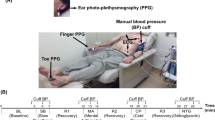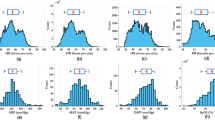Abstract
Characteristics obtained from peripheral pulses can be used to assess the status of cardiovascular system of subjects. However, nonintrusive techniques are preferred when prolonged monitoring is required for their comfort. Pulse transit time (PTT) measurement has showed its potentials to monitor timing changes in peripheral pulse in cardiovascular and respiratory studies. In children, the common peripheries used for these studies are fingers or toes. Presently, there is no known study conducted on children to investigate the possible physiologic parameters that can confound PTT measure at these sites. In this study, PTT values from both peripheral sites were recorded from 55 healthy Caucasian children (39 male) with mean age of 8.4±2.3 years (range 5–12 years). Peripheries' path length, heart rate, systolic blood pressure, diastolic blood pressure (DBP) and mean arterial pressure (MAP) were measured to investigate their contributions to PTT measurement. The results reveal that PTT is significantly related to all parameters (P<0.05), except for DBP and MAP. Age is observed to be the dominant factor that affects PTT at both peripheries in a child. Regression equations for PTT were derived for measuring from a finger and toe, (6.09 age+189.2) ms and (6.70 age+243.0) ms, respectively.
This is a preview of subscription content, access via your institution
Access options
Subscribe to this journal
Receive 12 digital issues and online access to articles
$119.00 per year
only $9.92 per issue
Buy this article
- Purchase on Springer Link
- Instant access to full article PDF
Prices may be subject to local taxes which are calculated during checkout

Similar content being viewed by others
References
McGrath BP, Liang YL, Kotsopoulos D, Cameron JD . Impact of physical and physiological factors on arterial function. Clin Exp Pharmacol Physiol 2001; 28: 1104–1107.
Wilkinson IB et al. Heart rate dependency of pulse pressure amplification and arterial stiffness. Am J Hypertens 2002; 15: 24–30.
Nurnberger J et al. Diastolic blood pressure is an important determinant of augmentation index and pulse wave velocity in young, healthy males. J Hum Hypertens 2003; 17: 153–158.
Loukogeorgakis S et al. Validation of a device to measure arterial pulse wave velocity by a photoplethysmographic method. Physiol Meas 2002; 23: 581–596.
O'Rourke MF, Mancia G . Arterial stiffness. J Hypertens 1999; 17: 1–4.
Lantelme P et al. Heart rate: an important confounder of pulse wave velocity assessment. Hypertension 2002; 39: 1083–1087.
Cheung YF et al. Arterial distensibility in children and teenagers: normal evolution and the effect of childhood vasculitis. Arch Dis Child 2002; 87: 348–351.
Senzaki H et al. Age-associated changes in arterial elastic properties in children. Eur J Pediatr 2002; 161: 547–551.
Pollak MH, Obrist PA . Aortic-radial pulse transit time and ECG Q-wave to radial pulse wave interval as indices of beat-by-beat blood pressure change. Psychophysiology 1983; 20: 21–28.
Babchenko A et al. Increase in pulse transit time to the foot after epidural anaesthesia treatment. Med Biol Eng Comput 2000; 38: 674–679.
Pitson DJ, Sandell A, van den Hout R, Stradling JR . Use of pulse transit time as a measure of inspiratory effort in patients with obstructive sleep apnoea. Eur Respir J 1995; 8: 1669–1674.
Smith RP, Argod J, Pepin JL, Levy PA . Pulse transit time: an appraisal of potential clinical applications. Thorax 1999; 54: 452–458.
Katz ES, Lutz J, Black C, Marcus CL . Pulse transit time as a measure of arousal and respiratory effort in children with sleep-disordered breathing. Pediatr Res 2003; 53: 580–588.
Allen J, Murray A . Age-related changes in peripheral pulse timing characteristics at the ears, fingers and toes. J Hum Hypertens 2002; 16: 711–717.
Nitzan M, Khanokh B, Slovik Y . The difference in pulse transit time to the toe and finger measured by photoplethysmography. Physiol Meas 2002; 23: 85–93.
Netea RT, Smits P, Lenders JW, Thien T . Does it matter whether blood pressure measurements are taken with subjects sitting or supine? J Hypertens 1998; 16: 263–268.
No authors listed. Update on the 1987 Task Force Report on High Blood Pressure in Children and Adolescents: a working group report from the National High Blood Pressure Education Program. National High Blood Pressure Education Program Working Group on Hypertension Control in Children and Adolescents. Pediatrics 1996; 98: 649–658.
Behrman RE, Kliegman RM, Jenson HB . Nelson Textbook of Pediatrics 2004, 17th edn. WB Saunders Company: Philadelphia, 2004, p. 1486.
Avolio AP et al. Effects of aging on changing arterial compliance and left ventricular load in a northern Chinese urban community. Circulation 1983; 68: 50–58.
Tanaka H, DeSouza CA, Seals DR . Absence of age-related increase in central arterial stiffness in physically active women. Arterioscler Thromb Vasc Biol 1998; 18: 127–132.
Blacher J et al. Aortic pulse wave velocity as a marker of cardiovascular risk in hypertensive patients. Hypertension 1999; 33: 1111–1117.
Miura K et al. Pulse pressure compared with other blood pressure indexes in the prediction of 25-year cardiovascular and all-cause mortality rates: The Chicago Heart Association detection project in industry study. Hypertension 2001; 38: 232–237.
Author information
Authors and Affiliations
Corresponding author
Rights and permissions
About this article
Cite this article
Foo, J., Wilson, S., Williams, G. et al. Age-related factors that confound peripheral pulse timing characteristics in Caucasian children. J Hum Hypertens 19, 463–466 (2005). https://doi.org/10.1038/sj.jhh.1001846
Received:
Revised:
Accepted:
Published:
Issue Date:
DOI: https://doi.org/10.1038/sj.jhh.1001846
Keywords
This article is cited by
-
An optimal filter for short photoplethysmogram signals
Scientific Data (2018)
-
The study of gender differences in physiological variables upon irradiation of therapeutic ultrasound
International Journal of Precision Engineering and Manufacturing (2011)
-
Pulse transit time ratio as a potential marker for paediatric crural and brachial blood pressure index
Journal of Human Hypertension (2007)
-
Normality of Upper and Lower Peripheral Pulse Transit Time of Normotensive and Hypertensive Children
Journal of Clinical Monitoring and Computing (2007)



